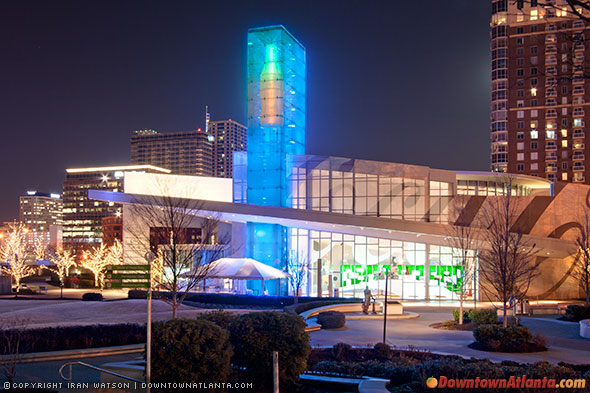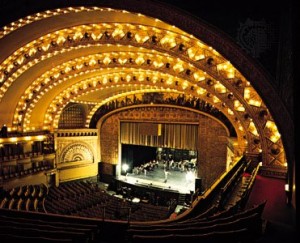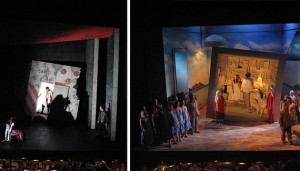Annotated Bibliography 10: Famous Places in Atlanta

From downtownatlanta.com
Gailliard, Ticara. “Famous Places in Atlanta, GA.” Traveltips.usatoday.com. Demand Media, n.d. Web. 28 Mar. 2016.
In this article, “Famous Places in Atlanta, GA”, Ticara Gailliard discusses some of the main attractions in Atlanta. She names some of the most famous places in Atlanta, such as the Georgia Aquarium, World of Coca-Cola, the CNN Center, and the Martin Luther King Jr, National Historic Site. She also provides a brief summary of each place and what it offers. Below the article, there are links to buy tickets, get coupons, and see special offers for the sites she named in the article. The intended audience for this is tourists and it was written with the purpose of informing them about the different places they could go to when they visit the city of Atlanta. Based on the places being advertised in the article, the intended audience could be families. This article would be useful to someone doing research on how the built environment of Atlanta is advertised and what parts are shown to outsiders in different states. It would also be useful to someone looking for activities to do while visiting Atlanta. Also, someone could compare this article to the previous article called “Why Atlanta Is The Big American City You’ve Been Missing Out On” and see how they are different and alike in the representation of Atlanta, based on the style of the article and the places being advertised in each article.
Annotated Bibliography 9: “The Big American City”

Photo by Barry Williams via Getty Images
Ledbetter, Carly. “Why Atlanta Is The Big American City You’ve Been Missing Out On.” The Huffington Post. TheHuffingtonPost.com, 5 Apr. 2014. Web. 28 Mar. 2016.
In her article, “Why Atlanta Is The Big American City You’ve Been Missing Out On“, Carly Ledbetter, from Huffington Post, argues that Atlanta is “one of the most amazing cities in America”. She starts off by addressing some misconceptions that people may have when they think of this city and then she quickly dismisses them. Then rest of the article is her list of twenty things about Atlanta that make it an “amazing city”. These include things like the tourist attractions, popular restaurants, art, music, the sports team, and historical landmarks. She also provides a graphic of some sort for each reason on the list, whether it is a picture or a GIF. The intended audience for this article could be someone that has never been to Atlanta, tourists, and potential residents of Atlanta. Based on most of the reasons she provided, the intended audience could also be for people in the 15-25 age group. Her purpose is to inform, but also persuade someone that has never been Atlanta to come. This would be a helpful resource for someone that is doing research on how the city of Atlanta is portrayed and advertised in a digital built environment and what biases there are towards the city.
Annotated Bibliography 8 : “Stars Flock to Atlanta”

Panoramic from carrollmorgan.com
Severson, Kim. “Stars Flock to Atlanta, Reshaping a Center of Black Culture.” Nytimes.com. The New York Times Company, 25 Nov. 2011. Web. 27 Mar. 2016.
In her article “Stars Flock to Atlanta, Reshaping a Center of Black Culture”, Kim Severson, from The New York Times, claims that Atlanta “is emerging as an epicenter of the black glitterati”. To support her claim she begins with talking about the Soul Train Awards being hosted in the Fox Theater and how “a few years ago, the city probably would not have been able to pull off such a show”. She provides statements from Stephen Hill, an executive vice President for BET where he gives his opinion of Atlanta. He says that ” it’s so ripe with African American flavor and talent”. He also says “Atlanta is home to our core audience” and “Atlanta is our New York, our LA”.
Then Severson gives examples of successful black people in the industry who have homes or business in Atlanta such ass, Tyler Perry, Sean Combs, Ce L Green, Ludacris, and Gladys Knight.
She explains the Entertainment Industry Investment Act passed in 2008, “which gives qualified productions a 20 percent tax break” and “producers who embed the Georgia promotional logo in the titles or credits can take another 10 percent off the tax bill”.
Next, she discusses the “decade of migration of black [stars] from the North”. Some of the reasons behind this is cheaper living and lower production costs. Severson provides a statement from Warrington Hudlin, president of the Black Filmmaker Foundation in New York, where he claims that” Atlanta is becoming the black Hollywood” and that “because many black filmmakers are working on tighter budgets than white filmmakers, they need to save money and Georgia helps them do that”. Another benefit of them living in Atlanta is less paparazzi.
The intended audience for this article is people in the film industry. The purpose of her article is to convince them to consider Atlanta as a place to conduct their businesses and do movies in this city .It is also to inform them of some of the pros of living in Atlanta as a person in the film, television and entertainment industry.
This would be a helpful source for someone doing research on how the built environment of Atlanta influences certain races to live there based on the types of careers that they have and how much they are willing to spend to live here.
Annotated Bibliography 7: “Atlanta is the new Hollywood”
Moore, Christine. ““Atlanta Is the New Hollywood”: Influx of Film and TV Production Boosts Economy, Attracts Actors.” ArtsATL.com. N.p., 04 June 2013. Web. 27 Mar. 2016.
In her article, “Atlanta is the new Hollywood : Influx of film and TV production boosts economy, attracts actors”, Christine Moore, claims that Atlanta’s film industry is growing and becoming the new Hollywood.
She starts by giving a little bit of background about the careers of, Scott Poythress and Claire Bronson, two actors that are from the Atlanta area. She states that back in 2007, they moved from Decatur to Los Angles “in pursuit of more auditions, better roles, and bigger opportunities”. Two years later they moved back to the “metro Atlanta” area, and Moore tells why. She discusses how Atlanta became more inviting to people in the film and media production industry, due to the “well-publicized tax credits that Georgia started offering in 2008”. Then she explains how the tax credit works. When “movie, television, and digital entertainment companies” work and hire within the state of Georgia, they “can receive up to 30 percent in tax breaks “. She continues her article by discussing some of the “new local studios slated for construction” and “new major production facilities” in Atlanta. They include, “a 400,000-square-foot complex in Gwinnett County with 12 sound stages, to be built by Jacoby Development, and a 288-acre development in Fayette County by Pinewood Shepperton, the British studio that’s home to the James Bond franchise”.
Then she goes into talking about how the economy has benefited from the new facilities. According to the Georgia Film, Music & Digital Entertainment Office, “Georgia-based productions generated $3.1 billion for the state economy in fiscal 2012, up 29 percent from the year before”. She also talks about how Atlanta-based actors are benefited, because they do not have to leave town for work.
The intended audience for this article could be actors, film production companies, aspiring actors, film students, and anyone else in the film industry. This article will be helpful to someone doing research on the how the built environment of Atlanta affects the entertainment industry or how it benefits the economy. It could be useful to a film student in Atlanta with concerns about finding work after college or an aspiring actor in Atlanta who is trying to decide if they should relocate or stay in Atlanta.
Annotated Bibliography 6 : Unit Two
“Resources_IdeasInfo_typesandformsoftheatre.pdf.” Web. 20 Feb. 2016.
In their article, “Types and Forms of Theatre”, Theatre Projects Consultants, a group of specialists who build performance spaces, claim that, “There is no ideal size of a theatre [because] the scale of a theatre depends on the size of the staging required by the type of performance and the number of audience to be accommodated, with each variable influencing the other as they change.” To support their claim, they explain the different types of performance spaces and the purpose of each type. The types of spaces they describe are drama, music, opera, dance,multipurpose, worship, teaching, media interaction and entertainment. To further explain, they give detailed descriptions of each type and provide examples of these theaters from various cities. The purpose of this article is to explain the different types of theater set-ups and their purposes. It will be a useful source to someone that wants to know about how the function of a theater influences its design.
Annotated Bibliography 5: Unit Two
“Theatre Design – The Goals of Theatre Design | Architecture.” Encyclopedia Britannica. N.p., n.d. Web. 19 Feb. 2016.
In their article, “Theatre Design – The Goals of Theatre Design”, the editors of Encyclopedia Britannica, a global educational publisher, they claim that “Theatre design is primarily concerned with enhancing the experience the audience can have at a performance [and] the specific architectural elements considered ideal for improving that experience will differ from culture to culture and sometimes even between subcultures within a given culture.” To support this claim, they describe two different categories of elements in a design, each being used for a different purpose. The two categories are “those that serve the aesthetics deemed appropriate for the art of theatre in a given culture, and those that optimize the experience of that art for the audience.” In the article they provide information on each of them, stating that “Those elements that serve the aesthetics of the art of theatre can involve everything from what the performers need to reach the artistic standards deemed proper before a performance starts to what they need to support the required amount of spectacle during performance, whether it be a bare stage or a stage with enormous movable sets and a spectacular array of props.” In contrast, “The elements that are most often discussed in terms of optimizing the experience had by the audience revolve around audience comfort”. Then they explain which areas of the theatre fit in each category. They state that, “those elements of a theatre’s design that serve primarily to optimize the experience of the audience are the house and the… ‘front-of-house’ facilities” and “those elements of the design of a theatre that serve primarily the aesthetics of theatre performance are the stage and the…backstage spaces”. They then describe each area in detail. The purpose of this article is to provide information on the purposes of theater design. This will be a useful source for someone that is interested in finding out why theaters are designed a certain way.
Annotated Bibliography 4: Unit Two
Lehman, Maria Lorena. “Take Note When Experiencing Theater Set Design.” Sensing Architecture ® Academy | Maria Lorena Lehman. N.p., 7 Dec. 2009. Web. 20 Feb. 2016.
In her article, “Take Note When Experiencing Theater Set Design”, Maria Lehman, an architectural author, designer and educator, claims that “theater set design must work to create an experience with space, and often such theatrical experiences tap into so much more that just the visual sense.” To support her claim, she gives explains how the environment of the theater set is used to engage the audience in the show. In the article, Lehman states that ” a theater stage (say for a musical) can be perceived as a micro-environment in that it must accomplish a lot with a little amount of space.” She suggests architects to consider how the limited space of the stage affects the transitions in a performance. The purpose of this article is to raise encourage architects to “keep in mind how the set design experience really caters to the senses.” This would be a useful source to someone that is interested in learning about the importance of the set up of the stage in a theater and how the size of the stage affects the performance.
Annotated Bibliography 2 (unit one)
Mathiowetz, Dianne. “Atlanta Remembers Troy Davis on Sept. 21.” Text. Workers World. N.p., 13 Sept. 2012. Web. 3 Feb. 2016.
Dianne Mathiowetz, Co-Coodinator and Representative of IAC (International Action Center) in Georgia Peace & Justice Coalition, a network for organizations and individuals that advocate for global justice and peace, in her article, “Atlanta Remembers Troy Davis on Sept. 21” gives insight on the case of Troy Anthony Davis in 2011 and its effect on the community around him and in his hometown. She explains that he was given the death sentence for a crime that he did not commit. Then she gives information on the protests and rallies conducted in honor of Troy Davis. Mathiowetz, continues with scheduled dates for a protest and march during that time. She also provided examples of how Davis was honored, like changing Woodruff Park’s name to Troy Davis Park. This article was written with the purpose of raising awareness to social injustices in Georgia, specifically Atlanta, and to encourage the members of this community was to join the cause and is a useful source to someone seeking information on the community’s involvement with social justice issues.
Annotated Bibliography 1 (Unit One)
International Business, Times. “Occupy Atlanta Protesters Ignore Police Order to Leave Woodruff Park.” International Business Times Nov. 0010: Regional Business News. Web. 2 Feb. 2016.
International Business Times, an online news publication, reports in their article, “Occupy Atlanta Protesters Ignore Police Order to Leave Woodruff Park” that “Several hundred protesters [occupied] Woodruff Park in Atlanta…in the latest outgrowth of a national movement that began [the previous month] with Occupy Wall Street.” They provide statements from the protest representatives involved and their reasons for protest, while explaining how they relate to historical views of Martin Luther King Jr in his “Letter from a Birmingham Jail” in 1963.” They also shed light on similar protests that occur in other cities, such as Boston, Chicago, and Los Angeles. The intended audience for this article would be someone interested in historical occurrences of civil rights activism in Atlanta and it would be a useful source for them to use as an example of this.
Annotated Bibliography 3 (unit one)
Reitzes, Donald C. et al. “Home or Office? The Homeless and Atlanta’s Downtown Park.” Sociological Focus 48.1 (2015): 28–48. Web. 4 Feb. 2016.
In the article “Home or Office? The Homeless and Atlanta’s Downtown Park”, authors Donald C. Reitzes, Timothy J. Crimmins, Johanna Yarbrough, and Josie Parker, of Georgia State University completed a case study which claims that ” as a general use space, the homeless did not identify the park as “home,” but did use it for their private purposes.” This claim is supported with research conducted by the authors on how the space is used by homeless people, based on symbolism, special characteristics of the area, activities they do in the park and the general use of the park. The purpose of this article is to provide information on how homeless people take the park and use it as a resource to complete their everyday activities. This article would be a useful source for other scholars doing research on the living conditions of homeless people in Atlanta.


